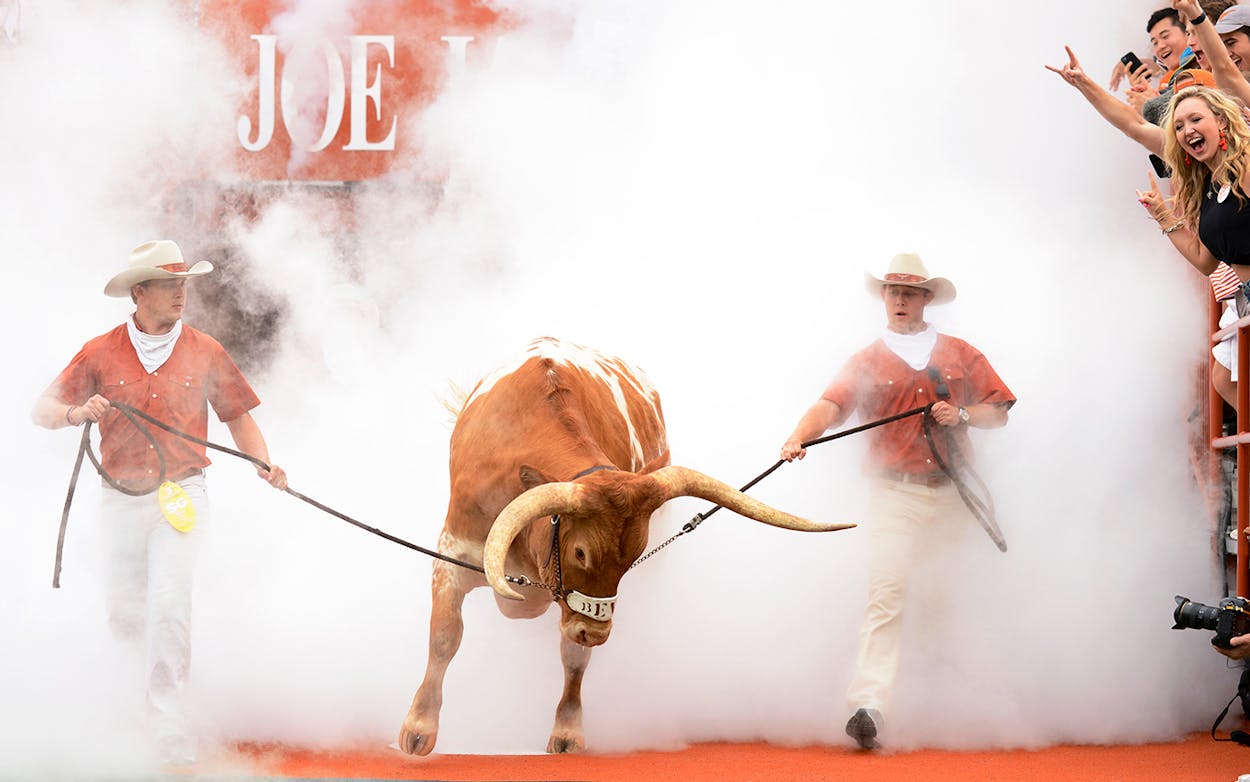Bevo, the Longhorn mascot (and, it should be noted, actual Longhorn), has been a part of the University of Texas football tradition for over a century. There’ve been fifteen steers to bear the name. Some eventually died of old age or cancer; others were retired after short runs representing the school; the first was barbecued and eaten. And Bevo XV, the latest Longhorn to be pressed into service, earned a new distinction last night: the first Bevo to nearly kill an opposing mascot on the field before the game.
The encounter at the Sugar Bowl, when Bevo met University of Georgia Bulldogs mascot Uga, immediately caught the attention of sports Twitter.
Bevo not a fan of Uga pic.twitter.com/3jhBEOnKhy
— Jonathan bonds (@bonds_jonathan) January 2, 2019
"new year, new me"
— SB Nation (@SBNation) January 2, 2019
– Bevo pic.twitter.com/vOqhSmdXnl
The encounter was hardly representative of the two teams’ stature heading into the game. The Longhorns entered the Superdome an 11.5 underdog, facing off against a higher-ranked SEC power. Bevo, meanwhile, as a beast weighing in at well over a thousand pounds, looked like a bully compared to the lil’ bulldog. The fight (if you could call the quickly dissipated encounter a fight) was hardly fair, but it did the trick. Inspired by Bevo’s charge, the Longhorns powered through the favored Georgia team, resulting in a 28–21 victory.
This act of aggression from a mascot was thrilling to watch, especially as no creature was seriously hurt in the attack (Austin American-Statesman photographer Nick Wagner got a little scratched up). But it was also not the first reported incident of Bevo behaving badly. Many of the tales of Bevo’s orneriness are unsubstantiated, and there’s little specific documentation of exactly what happened, but the legend of Bevos I–XIV causing a ruckus endures.
Bevo II, for instance, reportedly rushed an SMU cheerleader, leaving the poor student to defend himself with a megaphone. Bevo III is said to have escaped his enclosure on campus, remaining at large for two days. Bevo IV is accused of having an ire for parked cars, while Bevo V’s wrath was reserved for the Baylor band, according to myth.
Those widely cited as examples of Bevo’s bad behavior most likely stemmed from the steer’s Wikipedia page, which lists them all in a recap of the mascot’s lineage. (As of January 2, the list also includes the encounter between Bevo and Uga.) The sourcing, though, is suspect: All four incidents are attributed to Football’s Most Wanted, a book-length listicle of fun facts about various football-related personalities (and a smattering of mascots). Inside the book itself, however, the incidents are described as a single paragraph, offering no further documentation. Searching the archives of UT campus-affiliated publications such as the Daily Texan and the Alcalde offers no contemporaneous substantiation of the claims.
It’s possible, of course, that Bevo II rushed that cheerleader or that Bevo V scattered the Baylor band. On UT fan forums, Longhorns recall fondly the way that Bevo XIV—long regarded as a gentle beast—threatened the Baylor line in 2005, a reminder that it’s hardly uncharacteristic for cattle to react aggressively when approached by unfamiliar people. Might these other incidents have happened? Certainly. Could Bevo III have escaped campus for two days, leaving students and faculty awaiting his return? It’s less likely—Bevo III, who was not a Longhorn but a Hereford steer (with no horns to speak of), may have only been active for a single game against Rice in 1935, and no documentation of a steer running loose on campus for days exists. Bevo IV’s penchant for attacking parked cars might be true, or it might not—so little information about the creature exists.
What’s not impossible to know, though, is that Bevo XV is living up to the possibly apocryphal legend of Bevo as a wrathful beast who menaces the enemies of the Texas Longhorns and whose example is followed by the young men he represents. Uga survived, but the Georgia Bulldogs were defeated. Perhaps, then, a new legend began last night.








